Analyzing Mary Wollstonecraft's Feminist Philosophy and Legacy
VerifiedAdded on 2023/01/18
|7
|1784
|53
Essay
AI Summary
This essay delves into the life and works of Mary Wollstonecraft, focusing on her seminal text, "A Vindication of the Rights of Woman." It explores Wollstonecraft's significance as a foundational figure in modern feminism, examining her arguments for women's education, equality, and autonomy. The essay analyzes her critique of societal norms, her advocacy for women's intellectual development, and her vision for a society where women are not subservient to men but are empowered to make their own choices. It also discusses the historical context of Wollstonecraft's work, the influence of the French Revolution, and the lasting impact of her ideas on subsequent waves of feminism. The essay further connects Wollstonecraft's philosophy to contemporary feminist issues, highlighting the continuing relevance of her ideas in the ongoing struggle for gender equality.
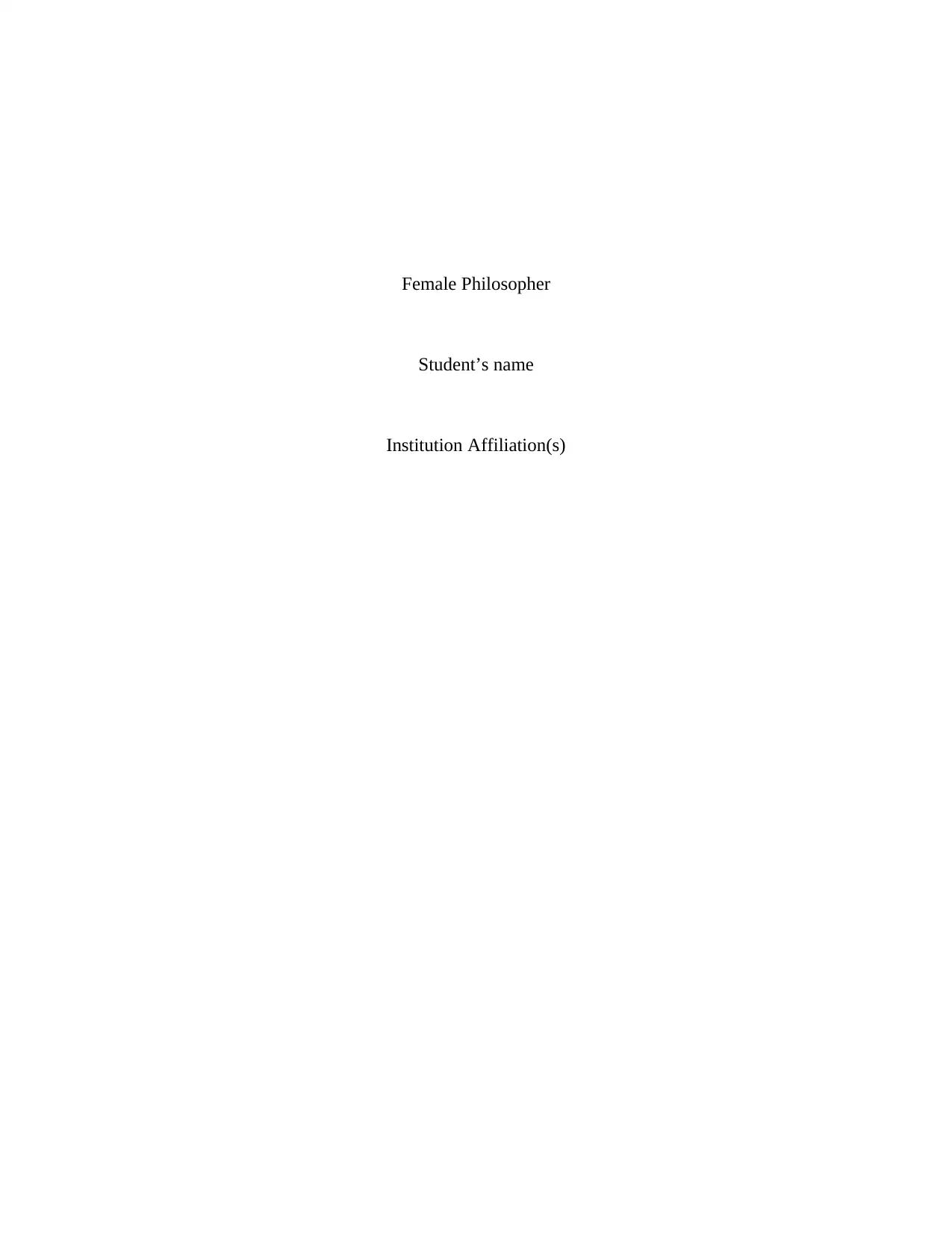
Female Philosopher
Student’s name
Institution Affiliation(s)
Student’s name
Institution Affiliation(s)
Paraphrase This Document
Need a fresh take? Get an instant paraphrase of this document with our AI Paraphraser
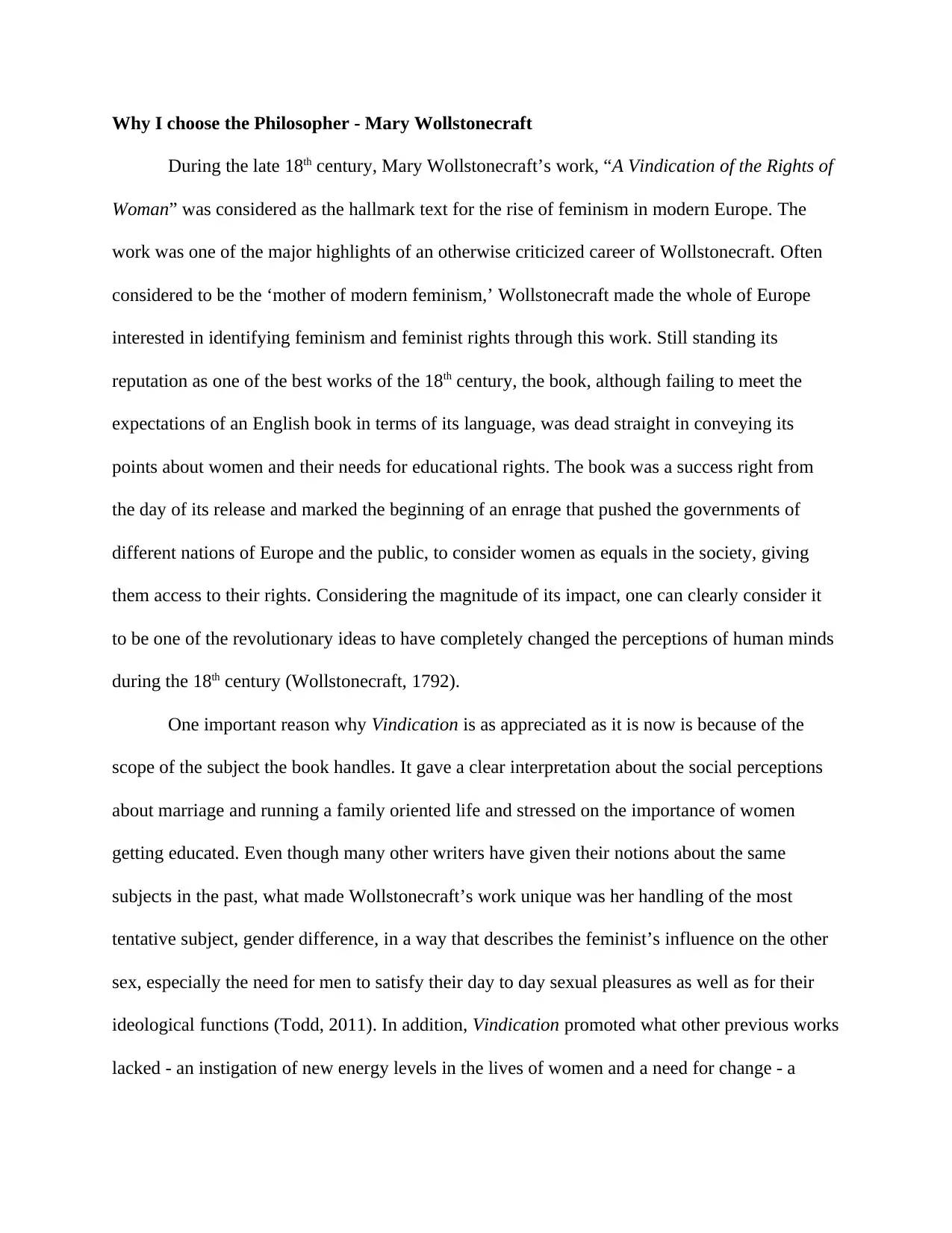
Why I choose the Philosopher - Mary Wollstonecraft
During the late 18th century, Mary Wollstonecraft’s work, “A Vindication of the Rights of
Woman” was considered as the hallmark text for the rise of feminism in modern Europe. The
work was one of the major highlights of an otherwise criticized career of Wollstonecraft. Often
considered to be the ‘mother of modern feminism,’ Wollstonecraft made the whole of Europe
interested in identifying feminism and feminist rights through this work. Still standing its
reputation as one of the best works of the 18th century, the book, although failing to meet the
expectations of an English book in terms of its language, was dead straight in conveying its
points about women and their needs for educational rights. The book was a success right from
the day of its release and marked the beginning of an enrage that pushed the governments of
different nations of Europe and the public, to consider women as equals in the society, giving
them access to their rights. Considering the magnitude of its impact, one can clearly consider it
to be one of the revolutionary ideas to have completely changed the perceptions of human minds
during the 18th century (Wollstonecraft, 1792).
One important reason why Vindication is as appreciated as it is now is because of the
scope of the subject the book handles. It gave a clear interpretation about the social perceptions
about marriage and running a family oriented life and stressed on the importance of women
getting educated. Even though many other writers have given their notions about the same
subjects in the past, what made Wollstonecraft’s work unique was her handling of the most
tentative subject, gender difference, in a way that describes the feminist’s influence on the other
sex, especially the need for men to satisfy their day to day sexual pleasures as well as for their
ideological functions (Todd, 2011). In addition, Vindication promoted what other previous works
lacked - an instigation of new energy levels in the lives of women and a need for change - a
During the late 18th century, Mary Wollstonecraft’s work, “A Vindication of the Rights of
Woman” was considered as the hallmark text for the rise of feminism in modern Europe. The
work was one of the major highlights of an otherwise criticized career of Wollstonecraft. Often
considered to be the ‘mother of modern feminism,’ Wollstonecraft made the whole of Europe
interested in identifying feminism and feminist rights through this work. Still standing its
reputation as one of the best works of the 18th century, the book, although failing to meet the
expectations of an English book in terms of its language, was dead straight in conveying its
points about women and their needs for educational rights. The book was a success right from
the day of its release and marked the beginning of an enrage that pushed the governments of
different nations of Europe and the public, to consider women as equals in the society, giving
them access to their rights. Considering the magnitude of its impact, one can clearly consider it
to be one of the revolutionary ideas to have completely changed the perceptions of human minds
during the 18th century (Wollstonecraft, 1792).
One important reason why Vindication is as appreciated as it is now is because of the
scope of the subject the book handles. It gave a clear interpretation about the social perceptions
about marriage and running a family oriented life and stressed on the importance of women
getting educated. Even though many other writers have given their notions about the same
subjects in the past, what made Wollstonecraft’s work unique was her handling of the most
tentative subject, gender difference, in a way that describes the feminist’s influence on the other
sex, especially the need for men to satisfy their day to day sexual pleasures as well as for their
ideological functions (Todd, 2011). In addition, Vindication promoted what other previous works
lacked - an instigation of new energy levels in the lives of women and a need for change - a
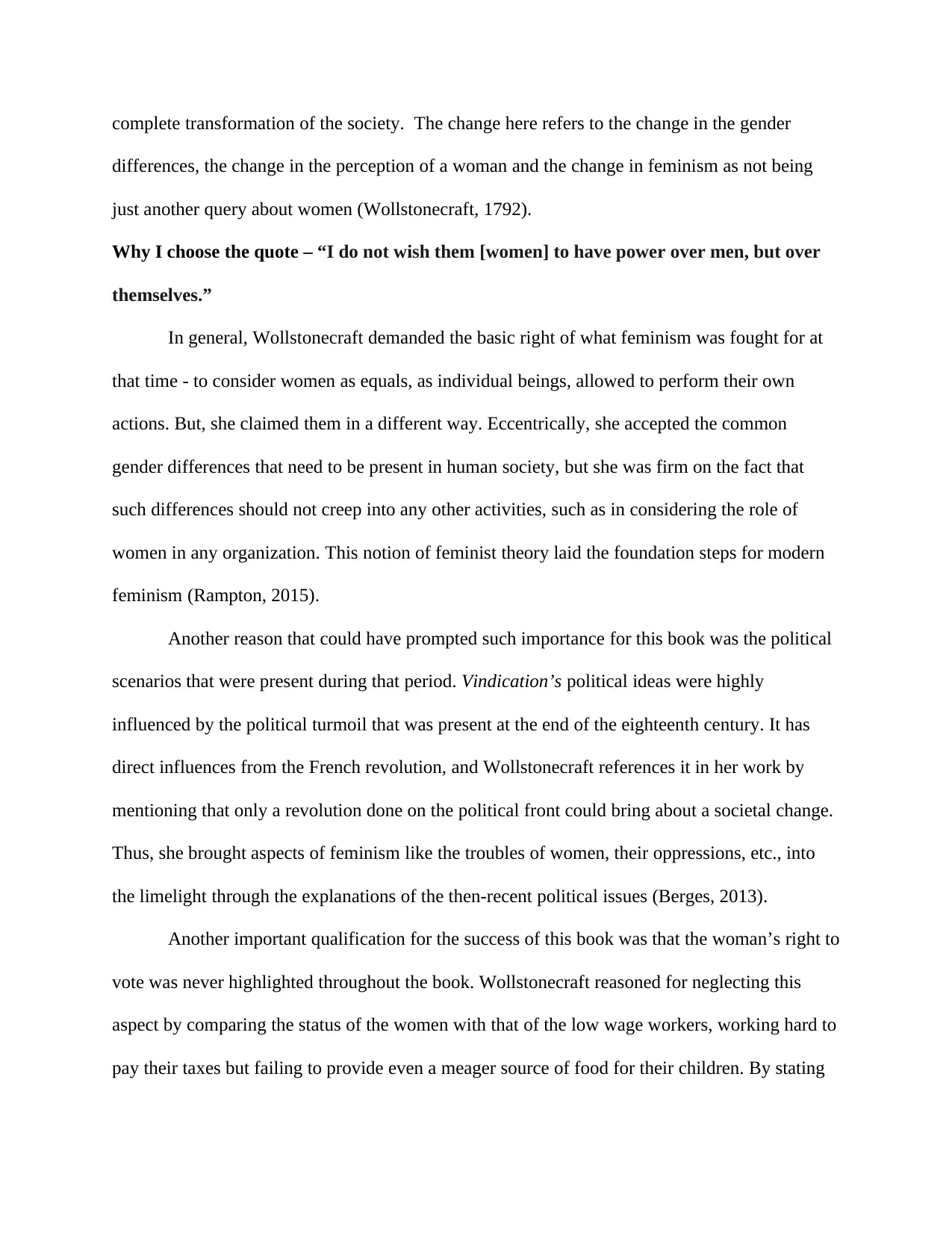
complete transformation of the society. The change here refers to the change in the gender
differences, the change in the perception of a woman and the change in feminism as not being
just another query about women (Wollstonecraft, 1792).
Why I choose the quote – “I do not wish them [women] to have power over men, but over
themselves.”
In general, Wollstonecraft demanded the basic right of what feminism was fought for at
that time - to consider women as equals, as individual beings, allowed to perform their own
actions. But, she claimed them in a different way. Eccentrically, she accepted the common
gender differences that need to be present in human society, but she was firm on the fact that
such differences should not creep into any other activities, such as in considering the role of
women in any organization. This notion of feminist theory laid the foundation steps for modern
feminism (Rampton, 2015).
Another reason that could have prompted such importance for this book was the political
scenarios that were present during that period. Vindication’s political ideas were highly
influenced by the political turmoil that was present at the end of the eighteenth century. It has
direct influences from the French revolution, and Wollstonecraft references it in her work by
mentioning that only a revolution done on the political front could bring about a societal change.
Thus, she brought aspects of feminism like the troubles of women, their oppressions, etc., into
the limelight through the explanations of the then-recent political issues (Berges, 2013).
Another important qualification for the success of this book was that the woman’s right to
vote was never highlighted throughout the book. Wollstonecraft reasoned for neglecting this
aspect by comparing the status of the women with that of the low wage workers, working hard to
pay their taxes but failing to provide even a meager source of food for their children. By stating
differences, the change in the perception of a woman and the change in feminism as not being
just another query about women (Wollstonecraft, 1792).
Why I choose the quote – “I do not wish them [women] to have power over men, but over
themselves.”
In general, Wollstonecraft demanded the basic right of what feminism was fought for at
that time - to consider women as equals, as individual beings, allowed to perform their own
actions. But, she claimed them in a different way. Eccentrically, she accepted the common
gender differences that need to be present in human society, but she was firm on the fact that
such differences should not creep into any other activities, such as in considering the role of
women in any organization. This notion of feminist theory laid the foundation steps for modern
feminism (Rampton, 2015).
Another reason that could have prompted such importance for this book was the political
scenarios that were present during that period. Vindication’s political ideas were highly
influenced by the political turmoil that was present at the end of the eighteenth century. It has
direct influences from the French revolution, and Wollstonecraft references it in her work by
mentioning that only a revolution done on the political front could bring about a societal change.
Thus, she brought aspects of feminism like the troubles of women, their oppressions, etc., into
the limelight through the explanations of the then-recent political issues (Berges, 2013).
Another important qualification for the success of this book was that the woman’s right to
vote was never highlighted throughout the book. Wollstonecraft reasoned for neglecting this
aspect by comparing the status of the women with that of the low wage workers, working hard to
pay their taxes but failing to provide even a meager source of food for their children. By stating
⊘ This is a preview!⊘
Do you want full access?
Subscribe today to unlock all pages.

Trusted by 1+ million students worldwide
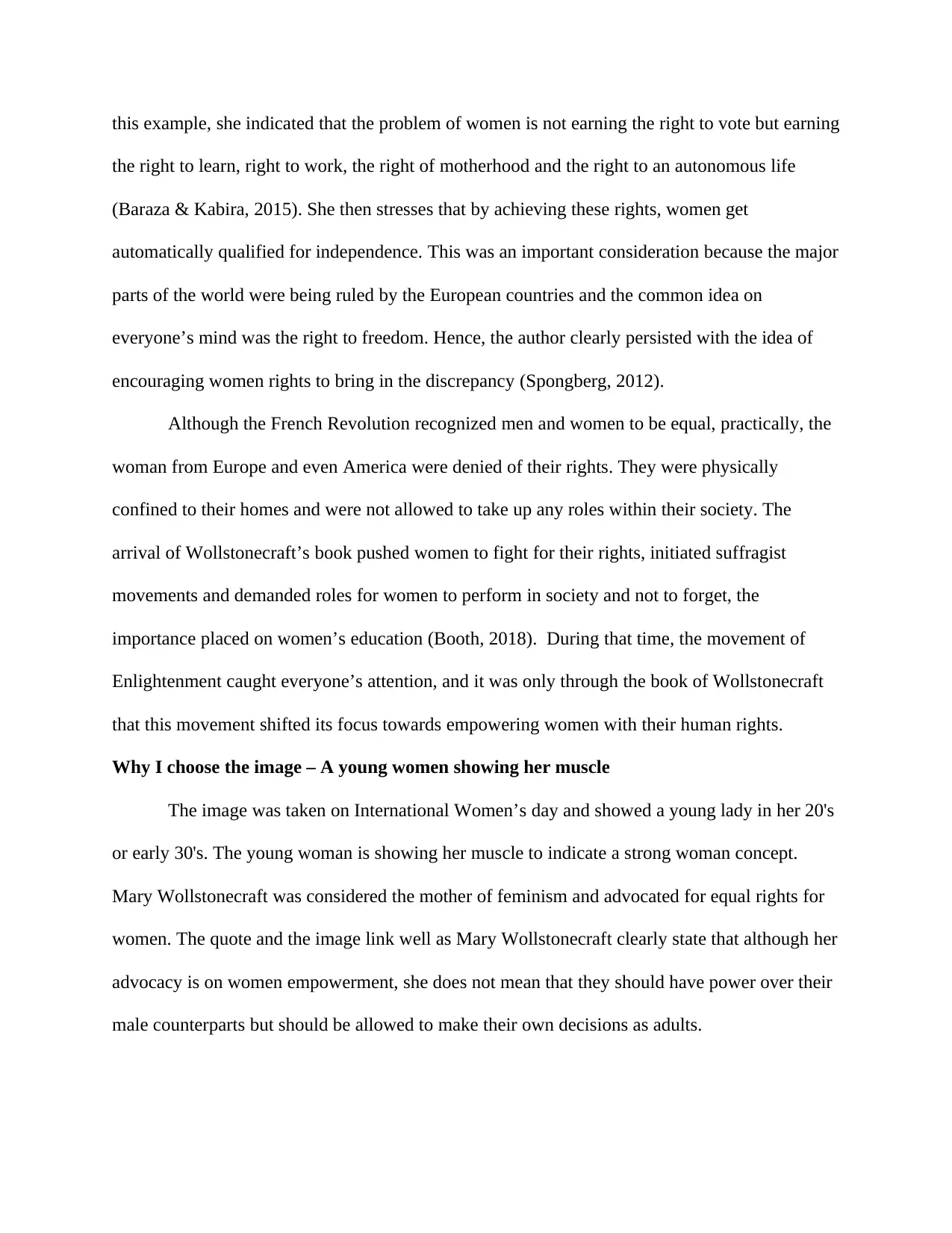
this example, she indicated that the problem of women is not earning the right to vote but earning
the right to learn, right to work, the right of motherhood and the right to an autonomous life
(Baraza & Kabira, 2015). She then stresses that by achieving these rights, women get
automatically qualified for independence. This was an important consideration because the major
parts of the world were being ruled by the European countries and the common idea on
everyone’s mind was the right to freedom. Hence, the author clearly persisted with the idea of
encouraging women rights to bring in the discrepancy (Spongberg, 2012).
Although the French Revolution recognized men and women to be equal, practically, the
woman from Europe and even America were denied of their rights. They were physically
confined to their homes and were not allowed to take up any roles within their society. The
arrival of Wollstonecraft’s book pushed women to fight for their rights, initiated suffragist
movements and demanded roles for women to perform in society and not to forget, the
importance placed on women’s education (Booth, 2018). During that time, the movement of
Enlightenment caught everyone’s attention, and it was only through the book of Wollstonecraft
that this movement shifted its focus towards empowering women with their human rights.
Why I choose the image – A young women showing her muscle
The image was taken on International Women’s day and showed a young lady in her 20's
or early 30's. The young woman is showing her muscle to indicate a strong woman concept.
Mary Wollstonecraft was considered the mother of feminism and advocated for equal rights for
women. The quote and the image link well as Mary Wollstonecraft clearly state that although her
advocacy is on women empowerment, she does not mean that they should have power over their
male counterparts but should be allowed to make their own decisions as adults.
the right to learn, right to work, the right of motherhood and the right to an autonomous life
(Baraza & Kabira, 2015). She then stresses that by achieving these rights, women get
automatically qualified for independence. This was an important consideration because the major
parts of the world were being ruled by the European countries and the common idea on
everyone’s mind was the right to freedom. Hence, the author clearly persisted with the idea of
encouraging women rights to bring in the discrepancy (Spongberg, 2012).
Although the French Revolution recognized men and women to be equal, practically, the
woman from Europe and even America were denied of their rights. They were physically
confined to their homes and were not allowed to take up any roles within their society. The
arrival of Wollstonecraft’s book pushed women to fight for their rights, initiated suffragist
movements and demanded roles for women to perform in society and not to forget, the
importance placed on women’s education (Booth, 2018). During that time, the movement of
Enlightenment caught everyone’s attention, and it was only through the book of Wollstonecraft
that this movement shifted its focus towards empowering women with their human rights.
Why I choose the image – A young women showing her muscle
The image was taken on International Women’s day and showed a young lady in her 20's
or early 30's. The young woman is showing her muscle to indicate a strong woman concept.
Mary Wollstonecraft was considered the mother of feminism and advocated for equal rights for
women. The quote and the image link well as Mary Wollstonecraft clearly state that although her
advocacy is on women empowerment, she does not mean that they should have power over their
male counterparts but should be allowed to make their own decisions as adults.
Paraphrase This Document
Need a fresh take? Get an instant paraphrase of this document with our AI Paraphraser
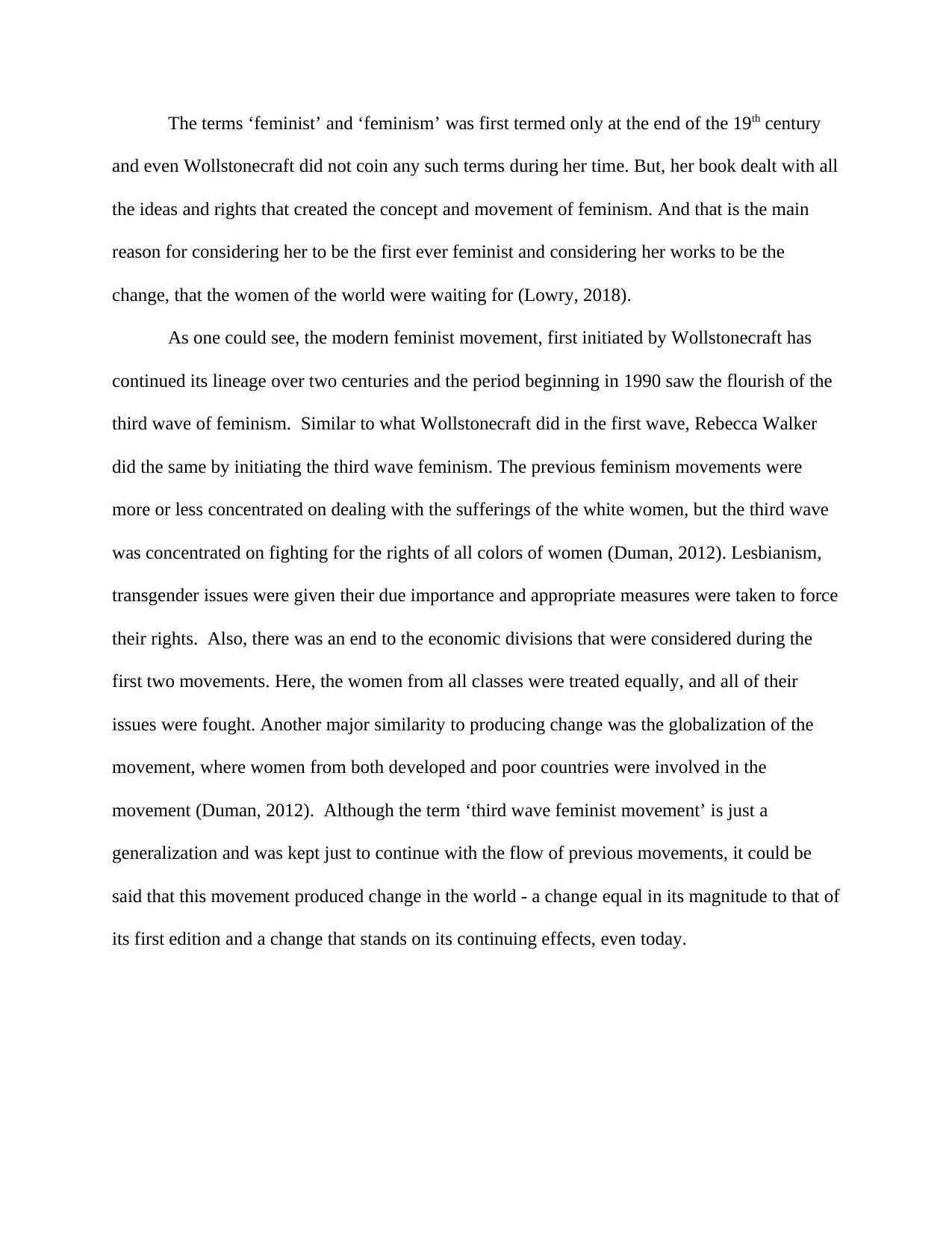
The terms ‘feminist’ and ‘feminism’ was first termed only at the end of the 19th century
and even Wollstonecraft did not coin any such terms during her time. But, her book dealt with all
the ideas and rights that created the concept and movement of feminism. And that is the main
reason for considering her to be the first ever feminist and considering her works to be the
change, that the women of the world were waiting for (Lowry, 2018).
As one could see, the modern feminist movement, first initiated by Wollstonecraft has
continued its lineage over two centuries and the period beginning in 1990 saw the flourish of the
third wave of feminism. Similar to what Wollstonecraft did in the first wave, Rebecca Walker
did the same by initiating the third wave feminism. The previous feminism movements were
more or less concentrated on dealing with the sufferings of the white women, but the third wave
was concentrated on fighting for the rights of all colors of women (Duman, 2012). Lesbianism,
transgender issues were given their due importance and appropriate measures were taken to force
their rights. Also, there was an end to the economic divisions that were considered during the
first two movements. Here, the women from all classes were treated equally, and all of their
issues were fought. Another major similarity to producing change was the globalization of the
movement, where women from both developed and poor countries were involved in the
movement (Duman, 2012). Although the term ‘third wave feminist movement’ is just a
generalization and was kept just to continue with the flow of previous movements, it could be
said that this movement produced change in the world - a change equal in its magnitude to that of
its first edition and a change that stands on its continuing effects, even today.
and even Wollstonecraft did not coin any such terms during her time. But, her book dealt with all
the ideas and rights that created the concept and movement of feminism. And that is the main
reason for considering her to be the first ever feminist and considering her works to be the
change, that the women of the world were waiting for (Lowry, 2018).
As one could see, the modern feminist movement, first initiated by Wollstonecraft has
continued its lineage over two centuries and the period beginning in 1990 saw the flourish of the
third wave of feminism. Similar to what Wollstonecraft did in the first wave, Rebecca Walker
did the same by initiating the third wave feminism. The previous feminism movements were
more or less concentrated on dealing with the sufferings of the white women, but the third wave
was concentrated on fighting for the rights of all colors of women (Duman, 2012). Lesbianism,
transgender issues were given their due importance and appropriate measures were taken to force
their rights. Also, there was an end to the economic divisions that were considered during the
first two movements. Here, the women from all classes were treated equally, and all of their
issues were fought. Another major similarity to producing change was the globalization of the
movement, where women from both developed and poor countries were involved in the
movement (Duman, 2012). Although the term ‘third wave feminist movement’ is just a
generalization and was kept just to continue with the flow of previous movements, it could be
said that this movement produced change in the world - a change equal in its magnitude to that of
its first edition and a change that stands on its continuing effects, even today.
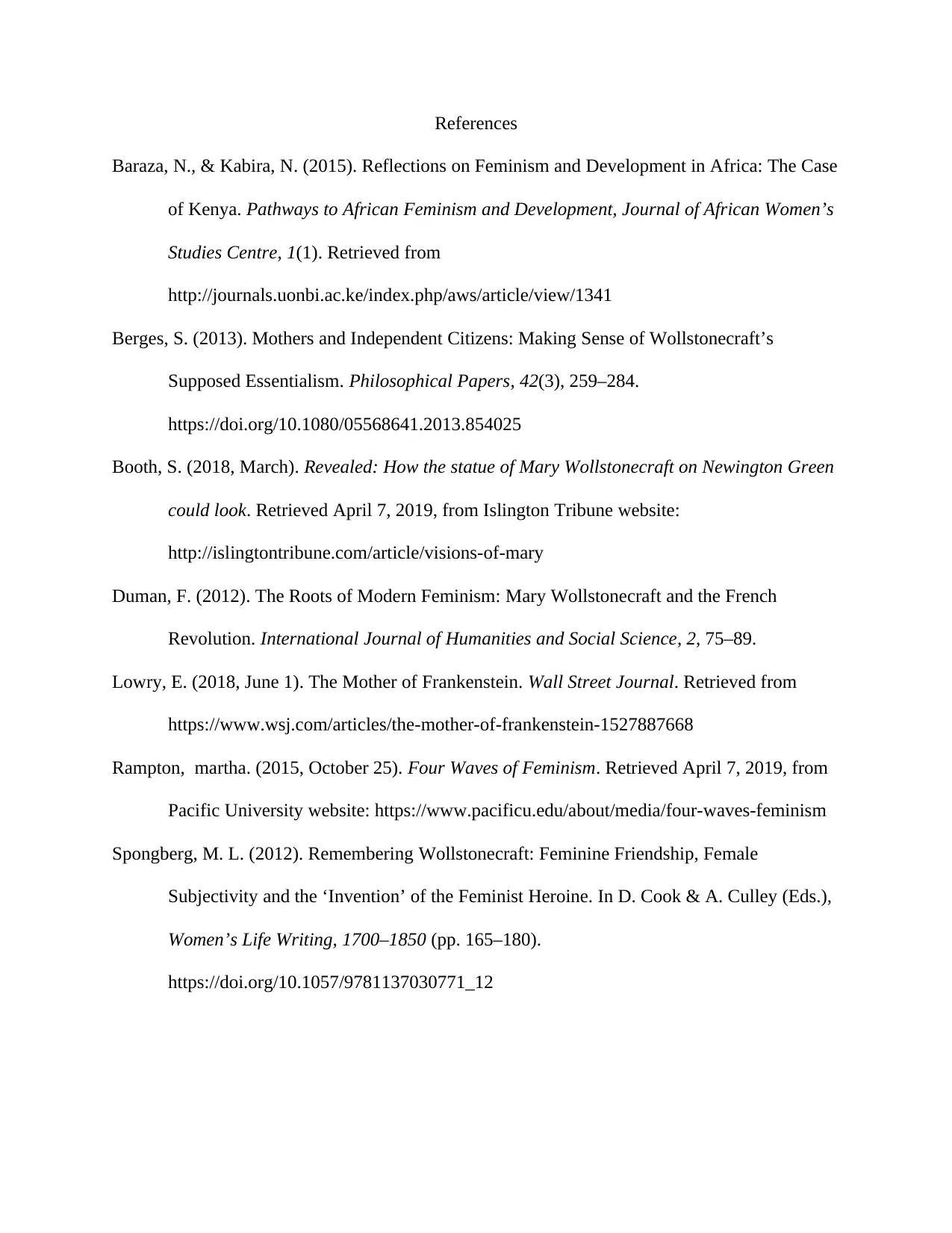
References
Baraza, N., & Kabira, N. (2015). Reflections on Feminism and Development in Africa: The Case
of Kenya. Pathways to African Feminism and Development, Journal of African Women’s
Studies Centre, 1(1). Retrieved from
http://journals.uonbi.ac.ke/index.php/aws/article/view/1341
Berges, S. (2013). Mothers and Independent Citizens: Making Sense of Wollstonecraft’s
Supposed Essentialism. Philosophical Papers, 42(3), 259–284.
https://doi.org/10.1080/05568641.2013.854025
Booth, S. (2018, March). Revealed: How the statue of Mary Wollstonecraft on Newington Green
could look. Retrieved April 7, 2019, from Islington Tribune website:
http://islingtontribune.com/article/visions-of-mary
Duman, F. (2012). The Roots of Modern Feminism: Mary Wollstonecraft and the French
Revolution. International Journal of Humanities and Social Science, 2, 75–89.
Lowry, E. (2018, June 1). The Mother of Frankenstein. Wall Street Journal. Retrieved from
https://www.wsj.com/articles/the-mother-of-frankenstein-1527887668
Rampton, martha. (2015, October 25). Four Waves of Feminism. Retrieved April 7, 2019, from
Pacific University website: https://www.pacificu.edu/about/media/four-waves-feminism
Spongberg, M. L. (2012). Remembering Wollstonecraft: Feminine Friendship, Female
Subjectivity and the ‘Invention’ of the Feminist Heroine. In D. Cook & A. Culley (Eds.),
Women’s Life Writing, 1700–1850 (pp. 165–180).
https://doi.org/10.1057/9781137030771_12
Baraza, N., & Kabira, N. (2015). Reflections on Feminism and Development in Africa: The Case
of Kenya. Pathways to African Feminism and Development, Journal of African Women’s
Studies Centre, 1(1). Retrieved from
http://journals.uonbi.ac.ke/index.php/aws/article/view/1341
Berges, S. (2013). Mothers and Independent Citizens: Making Sense of Wollstonecraft’s
Supposed Essentialism. Philosophical Papers, 42(3), 259–284.
https://doi.org/10.1080/05568641.2013.854025
Booth, S. (2018, March). Revealed: How the statue of Mary Wollstonecraft on Newington Green
could look. Retrieved April 7, 2019, from Islington Tribune website:
http://islingtontribune.com/article/visions-of-mary
Duman, F. (2012). The Roots of Modern Feminism: Mary Wollstonecraft and the French
Revolution. International Journal of Humanities and Social Science, 2, 75–89.
Lowry, E. (2018, June 1). The Mother of Frankenstein. Wall Street Journal. Retrieved from
https://www.wsj.com/articles/the-mother-of-frankenstein-1527887668
Rampton, martha. (2015, October 25). Four Waves of Feminism. Retrieved April 7, 2019, from
Pacific University website: https://www.pacificu.edu/about/media/four-waves-feminism
Spongberg, M. L. (2012). Remembering Wollstonecraft: Feminine Friendship, Female
Subjectivity and the ‘Invention’ of the Feminist Heroine. In D. Cook & A. Culley (Eds.),
Women’s Life Writing, 1700–1850 (pp. 165–180).
https://doi.org/10.1057/9781137030771_12
⊘ This is a preview!⊘
Do you want full access?
Subscribe today to unlock all pages.

Trusted by 1+ million students worldwide
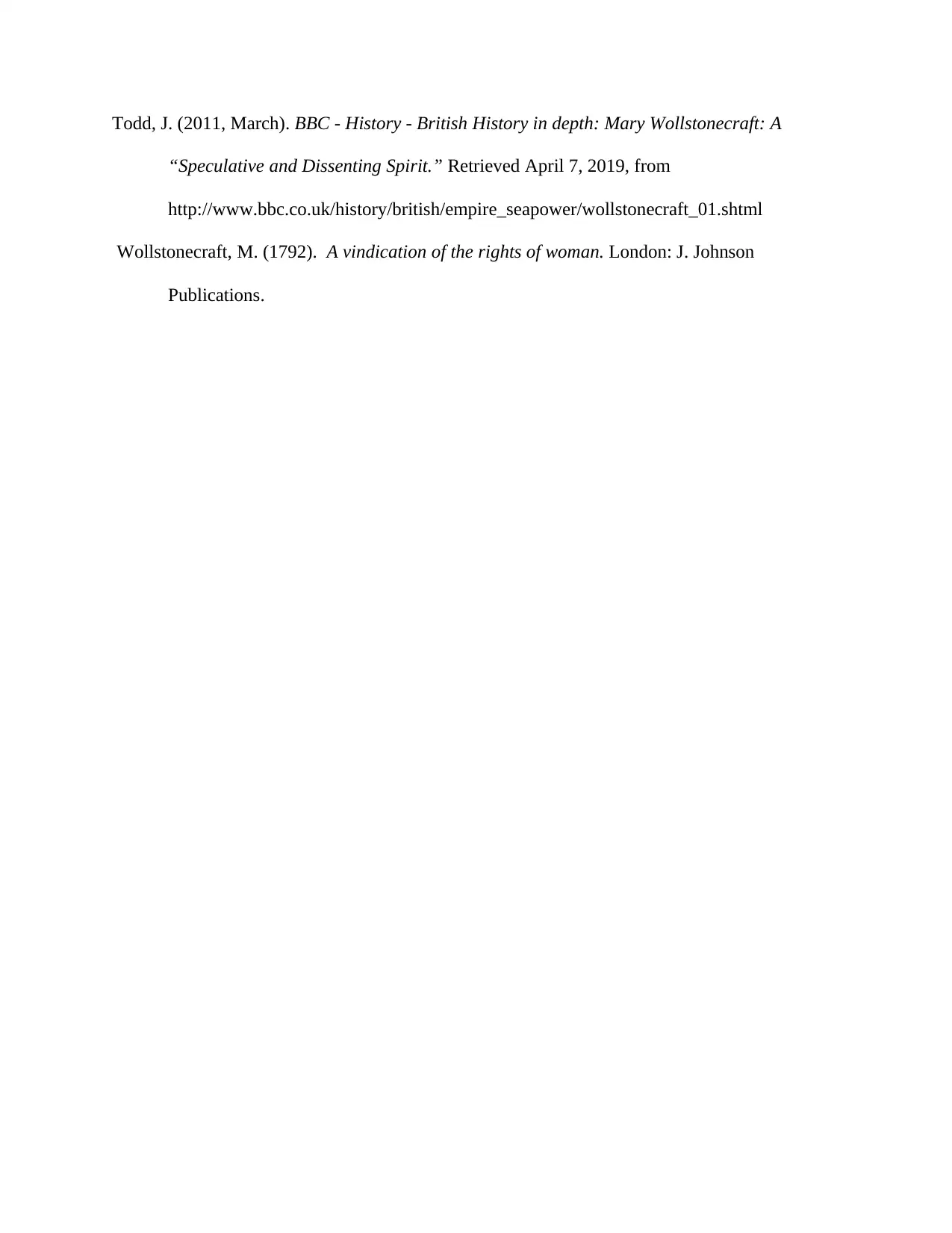
Todd, J. (2011, March). BBC - History - British History in depth: Mary Wollstonecraft: A
“Speculative and Dissenting Spirit.” Retrieved April 7, 2019, from
http://www.bbc.co.uk/history/british/empire_seapower/wollstonecraft_01.shtml
Wollstonecraft, M. (1792). A vindication of the rights of woman. London: J. Johnson
Publications.
“Speculative and Dissenting Spirit.” Retrieved April 7, 2019, from
http://www.bbc.co.uk/history/british/empire_seapower/wollstonecraft_01.shtml
Wollstonecraft, M. (1792). A vindication of the rights of woman. London: J. Johnson
Publications.
1 out of 7
Related Documents
Your All-in-One AI-Powered Toolkit for Academic Success.
+13062052269
info@desklib.com
Available 24*7 on WhatsApp / Email
![[object Object]](/_next/static/media/star-bottom.7253800d.svg)
Unlock your academic potential
Copyright © 2020–2025 A2Z Services. All Rights Reserved. Developed and managed by ZUCOL.





